Trooping Funnel – Identification, Edibility, Cooking, Sustainable Harvesting, Distribution
Infundibulicybe geotropa (previously clitocybe geotropa)
AKA. Trooping funnelcap, Giant Funnel, Monk’s Head, Rickstone Funnel Cap
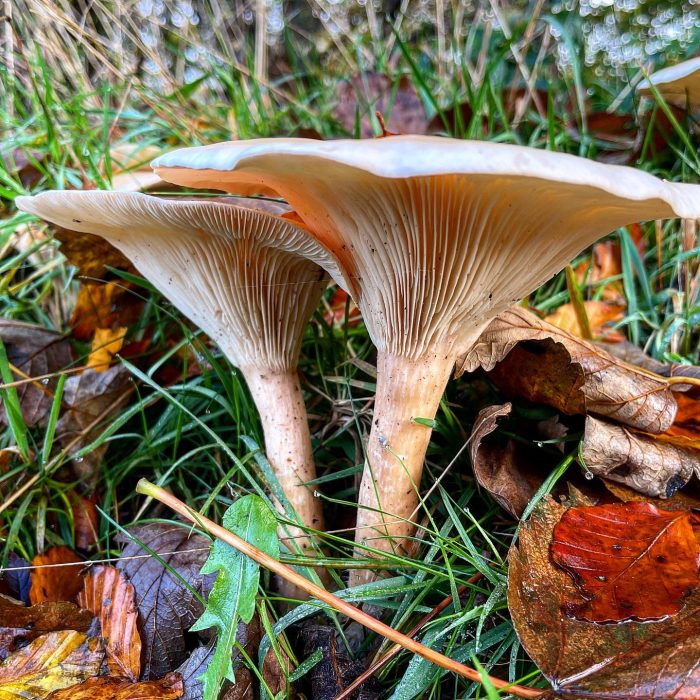
Trooping funnels
- Identification – 4/5 – Large – fully grown caps can be easily 20cm in diameter; Strongly decurrent gills (running down the stem); Strongly funnel shaped when mature; Always a raised boss (bump) in the centre of the cap (you may have to feel for it); Inrolled margin (cap edge) on younger specimens; White spores; Sweet-but-sharp floral fragrance, sometimes with a hint of bitter almonds; Trooping (gregarious) – you will very seldom find one on its own. Similar species: clouded agaric, tawny funnel which is smaller and brown/tan coloured (both similarly edible, though not so meaty or tasty). When harvesting from field edges, you should also be aware of the deadly poisonous grassland toadstool fools funnel (clitocybe rivulosa/dealbata). It is only superficially similar, distinguished by its much smaller size, white powdery cap and habitat. It lacks the raised central umbo that makes trooping funnels so distinctive. There is a good description of fools funnel here.
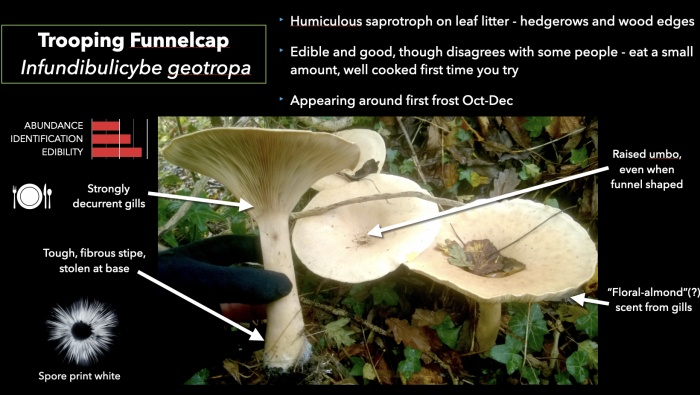
Trooping funnelcap – Identification, abundance edibility. They are discussed at length in my webinar “20 mushrooms to know before you die”. Image ©GallowayWildFoods.com
- Edibility – 4/5 – A delicious, meaty mushroom. I would have scored them 5/5, but occasionally people struggle to digest them – eat only a small amount, well cooked first time to make sure you get on with them. The caps are truly excellent, outscoring many more widely eaten wild mushrooms in a blind tasting I did with chefs. Discard the tough stipes (or add to the stock pot). Caps can be preserved by dehydrating or cooking then freezing, and are excellent pickled.
- Distribution – 4/5 – Common
- Habitat – Among deciduous leaf litter in woods, wood edges and hedgerows. These are saprophytic fungi, so can be found anywhere with rich, rotting deciduous leaf litter.
- Ecological Role – Saprophytic, rotting down leaf litter and nutrient rich woodland/hedgerow soil. Older caps can play home and nursery to fungal gnat and fly larvae.
- Season – October – January
- Sustainable Harvesting – These are common and prolific mushrooms, providing a great source of local, low carbon cost food. Such is there size and numbers that thinning a troop will leave plenty for other creatures to enjoy. As saprophytic fungi tend to deplete finite food resources they must seek out new substrates through their airborne spores, so don’t pick immature caps. By the time they have opened into a full funnel shape, they will already have dropped millions of spores, and the fungi, if it could express a preference, would probably thank you for transporting its spore-producing structures around the forest in an open basket! As leaf rotters, its advisable to harvest by cutting, as pulling will bring large lumps of mycelium and substrate with them. Read more on cutting v picking wild mushrooms here . If you do harvest the stem buts with some mycelium still attached, these can be sandwiched between thin sheets of wet cardboard, kept cool and damp, then introduced to new potential substrates (eg. a compost heap) when the growing mycelium is clearly visible on the cardboard. While such strategies are not guaranteed to be successful, large saprophytic fungi such as trooping funnels offer much higher chances of success than most other fungi
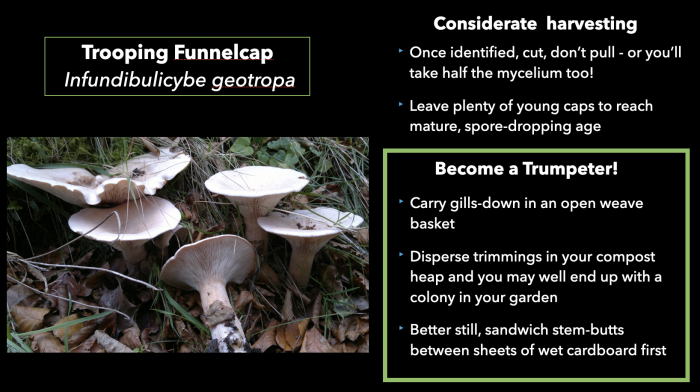
Large, distinctive, common and delicious, these mushrooms tick every box for the novice forager. Like many saprophytes (rotting) fungi, they tend to appear towards the end of autumn in hedgerows and deciduous wood edges.
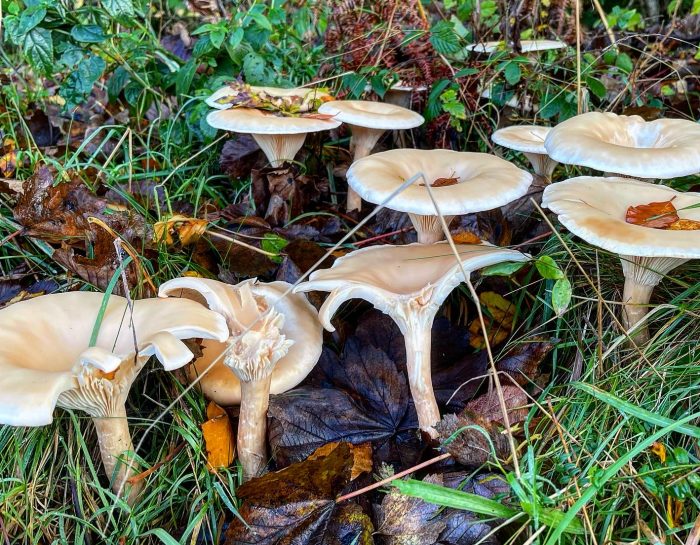
Trooping funnels tend to hang out in groups of 3 – 20 mushrooms, often in quite a small area
If all this sounds too good to be true…perhaps it is. A small proportion of people don’t get on with this mushroom (mild gastric upset). Personally, I think its such a delicious, meaty mushroom that its worth trying a small amount well cooked first time round. I’ve never met or heard of anyone who doesn’t get on with it. Such warnings tend to get over emphasised by nervous publishers. You don’t see bread cookbooks warning about gluten intolerance on every recipe. The stipes get tough so remove them and add to the stock pot.
Sear the caps as you would meat, until they start to caramelise, emphasising their rich umami.
They pickle well, and the process of simmering in the pickling solution is adequate for rendering them digestible to all, if you discard it after pickling and store the blewits under oil.
How to pickle wood blewits and other wild mushrooms
Related pages:
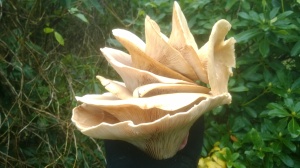
13 Comments
Excellent description. Thanks. Just enjoyed some: delicious with a little smoked duck and a piece of fried brioche. Yum. Christopher
Just found some of these! Can’t wait to have them with garlic, rosemary and butter on toast
Thanks for the helpful info 🙂
Just found a ring of their enormous lookalike, the Giant Funnel Cap. Worth eating? Books nervously indicate possible unpleasant gastric reactions in some people.
Eat a small amount, well cooked, first time. See how it goes.
Is there any way to preserve these? Would freezing work?
Caps can be preserved by dehydrating or cooking then freezing, and are excellent pickled.
Is there a pickling recipe you can recommend?
Yes – my method for pickling chanterelles is hidden in this post: You can switch the mushrooms around and the general principles still work. Thanks for reminding me to make a dedicated “pickling mushrooms” post – coming soon!
Mark
They are delicious and I have been eating them for about 3 weeks
I have given them to 7 other people and just one said she had mild stomach problems each time she tried them (twice) but nothing too worrying.
Brilliant description particularly of their smell. I would love to eat some of the troop that have lined up under the fence into our garden from nearby wood but partner says no. As a kid we were always eating horse mushrooms whereas partner more used to cellophane wrapped mushrooms only. Guess I will have to follow orders though. Will stick one on the compost heap to see what happens. Thank you.
We have some growing in our yard underneath a tree. They kinda look like a flower on top. My son said they weren’t poisonous but I started looking them up anyway. But are they poisonous to dogs or cats if they eat them raw?
Sorry, i’d need to be both a vet and a mycologist to advise on that!
Found this mushroom first time in my life , and thanks to this site was so easy to identify it . I just fried it on butter to try it first time , surprisingly good texture and flavour! Delicious, that I went to fry bit more after the first plate disappeared in minute .
Texture so perfect , I will try more recipes!